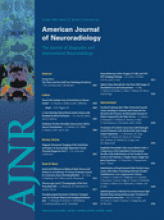Article Figures & Data
Tables
Description No. of Cases (N = 84) Neuroform stent placed 16 Broad neck (FNR < 2) 15 Operator’s discretion 13 Aneurysm >10 mm 12 Branch occlusion 7 Coil prolapse 5 Retreatment of aneurysm 5 Multilobulated dome 4 ICA sacrifice 3 Coil fracture and retrieval 2 Interstitial filling 2 Note:—FNR indicates fundus-to-neck ratio; ICA, internal carotid artery.
- Table 2:
Comparison of demographic and angiographic data between ruptured and unruptured groups (N = 79)
Variable Ruptured Unruptured Total Age (mean ± SD), y 55 ± 10 54 ± 11 55 ± 10 Female, N (%) 21 (66) 31 (66) 52 (66) Aneurysm diameter (mean ± SD), mm 7.4 ± 3.1 7.1 ± 3.4 7.3 ± 3.3 Location of aneurysm Anterior circulation Cavernous ICA 1 1 2 Paraclinoid ICA* 2 11 (1) 13 (1) Posterior communicating artery 4 (1) 3 7 (1) ICA dorsal wall 0 2 2 ICA bifurcation 0 1 1 Anterior communicating artery 7 9 16 Pericallosal artery 0 3 3 MCA bifurcation 2 3 5 Posterior circulation Basilar artery tip 9 (3) 13 22 (3) Superior cerebellar artery 1 1 2 Vertebrobasilar junction 2 0 2 Posterior inferior cerebellar artery 4 0 4 Total 32 (4) 47 (1) 79 (5) Note:—Numbers in parentheses denote retreated aneurysms. ICA indicates internal carotid artery; MCA, middle cerebral artery; Paraclinoid ICA aneurysms included all aneurysms arising from the superior hypophyseal artery, ophthalmic artery, carotid cave, and clinoidal ICA segment.
Description Patient No. Rupture/Unrupture Eptifibatide related Intracranial bleeding* 2 2/0 Groin hematoma 3 1/2 Thrombocytopenia† 2 2/0 Procedure related Arterial dissection 1 1/0 Intraprocedural rupture 2 1/0 Thromboembolic 1 1/0 * One patient with intraprocedural rupture was likely exacerbated with eptifibatide, and one patient had a hemorrorhagic transformation of a thromembolic infarction
† Both patients were on famotidine and one patient developed sepsis; thus, the etiology of the thrombocytopenia is unclear.
Study No. of Patients Treatment Intracranial Bleeding Events Recanalization Cronqvist et al3 19 IA urokinase 3 (16%) 10 (53%) Fourie and Duncan5 1 IV abciximab 0 (0%) 1 (100%) Ng et al8 1 IV abciximab 0 (0%) 1 (100%) Cloft et al9 4 IV abciximab 0 (0%) 2 (50%) Kwon et al10 3 IA abciximab 0 (0%) 3 (100%) Alexander et al11 1 IV abciximab 0 (0%) 1 (100%) Mounayer et al13 13 IA abciximab 0 (0%) 12 (92%) Bendok et al14 1 IV abciximab 0 (0%) 1 (100%) Song et al15 7 IA abciximab 0 (0%) 5 (71%) Note:—IA indicates intra-arterial; IV, intravenous.
Abciximab Tirofiban Eptifibatide Manufacturer Eli Lilly Merck COR Therapeutics Molecule size, datons 50,000 800 500 Receptor affinity (KD) High (5 nmol/L) Low (15 nmol/L) Low (120 nmol/L) Plasma high-life, h 0.2 1.5–2 2–4 Biologic half-life, h 12–24 1.5–2 2–4 Excretion Renal Renal/hepatic Renal Method of reversal Platelet transfusion Fresh-frozen plasma, cryprecipitate, platelet transfusion Fresh-frozen plasma, cryprecipitate, platelet transfusion












